Human Resources Management: Parker Smallgoods Safety Culture Report
VerifiedAdded on 2023/06/05
|10
|2247
|407
Report
AI Summary
This report examines the safety culture within Parker Smallgoods, a manufacturing company, focusing on the critical role of human resources management in ensuring workplace safety. The introduction highlights the significance of safety in the manufacturing sector, emphasizing how accidents can affect productivity. The report delves into the legal responsibilities of employers, including risk assessment, fair treatment, state legislation, code of conduct, and workers' compensation, all of which contribute to a safe working environment. A literature review explores the impact of safety culture on manufacturing, including its ability to enhance employee retention, increase productivity, and reduce financial expenditures. The importance of strong leadership, regular monitoring, and effective communication in fostering a safe workplace culture is also discussed. The report concludes that a strong safety culture is essential for the manufacturing industry and highlights the need for employers to comply with legal standards and prioritize employee safety through communication, supportive leadership, and employee awareness.
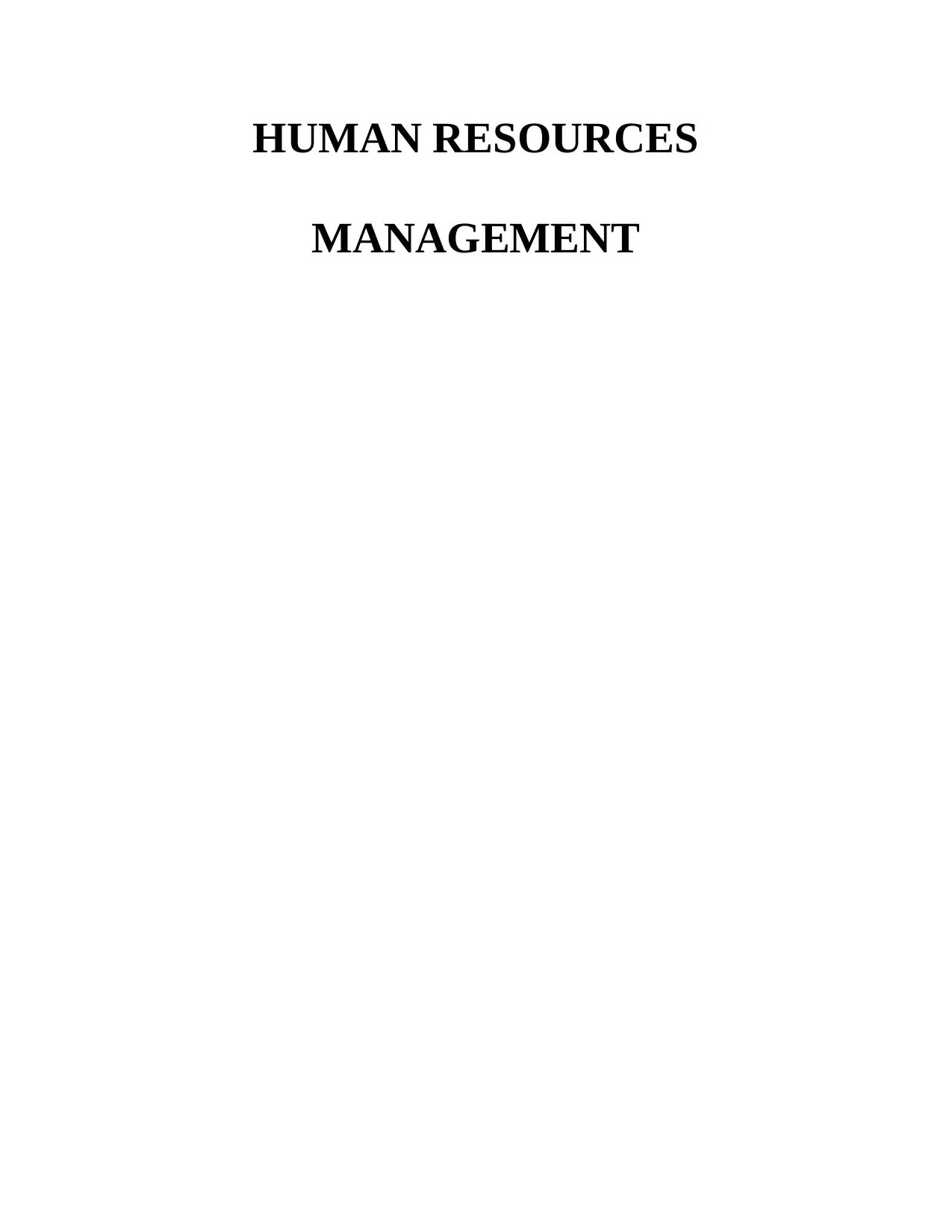
HUMAN RESOURCES
MANAGEMENT
MANAGEMENT
Paraphrase This Document
Need a fresh take? Get an instant paraphrase of this document with our AI Paraphraser
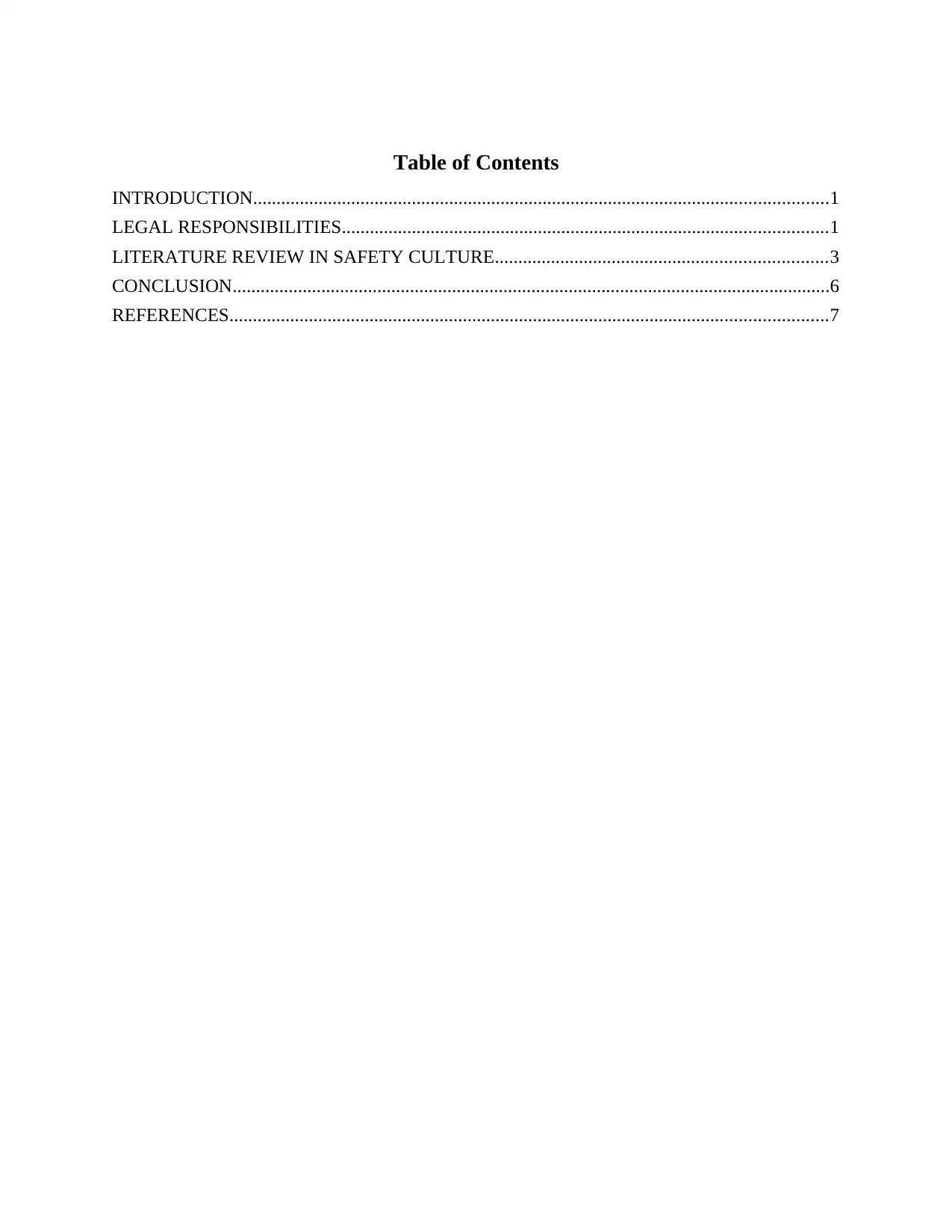
Table of Contents
INTRODUCTION...........................................................................................................................1
LEGAL RESPONSIBILITIES........................................................................................................1
LITERATURE REVIEW IN SAFETY CULTURE.......................................................................3
CONCLUSION................................................................................................................................6
REFERENCES................................................................................................................................7
INTRODUCTION...........................................................................................................................1
LEGAL RESPONSIBILITIES........................................................................................................1
LITERATURE REVIEW IN SAFETY CULTURE.......................................................................3
CONCLUSION................................................................................................................................6
REFERENCES................................................................................................................................7
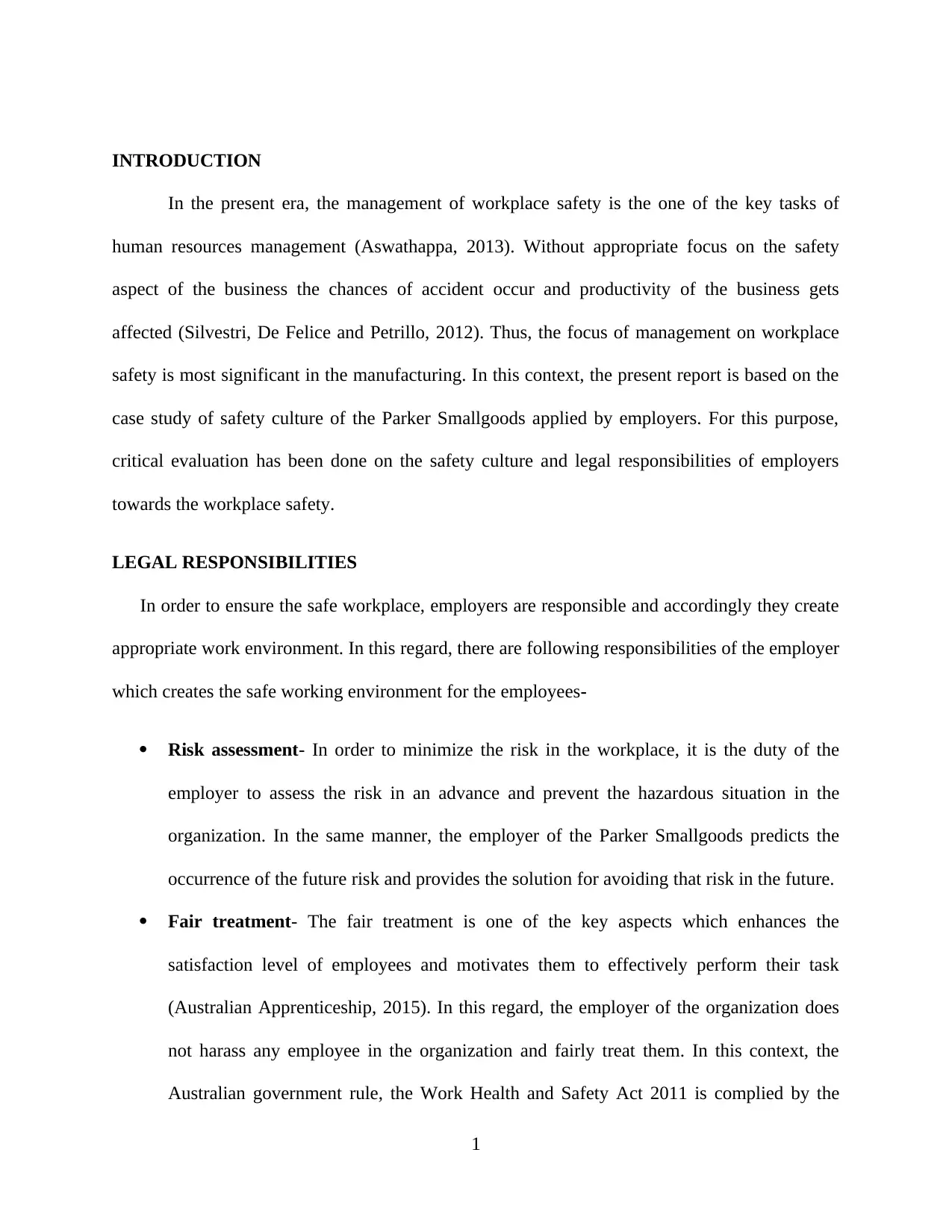
INTRODUCTION
In the present era, the management of workplace safety is the one of the key tasks of
human resources management (Aswathappa, 2013). Without appropriate focus on the safety
aspect of the business the chances of accident occur and productivity of the business gets
affected (Silvestri, De Felice and Petrillo, 2012). Thus, the focus of management on workplace
safety is most significant in the manufacturing. In this context, the present report is based on the
case study of safety culture of the Parker Smallgoods applied by employers. For this purpose,
critical evaluation has been done on the safety culture and legal responsibilities of employers
towards the workplace safety.
LEGAL RESPONSIBILITIES
In order to ensure the safe workplace, employers are responsible and accordingly they create
appropriate work environment. In this regard, there are following responsibilities of the employer
which creates the safe working environment for the employees-
Risk assessment- In order to minimize the risk in the workplace, it is the duty of the
employer to assess the risk in an advance and prevent the hazardous situation in the
organization. In the same manner, the employer of the Parker Smallgoods predicts the
occurrence of the future risk and provides the solution for avoiding that risk in the future.
Fair treatment- The fair treatment is one of the key aspects which enhances the
satisfaction level of employees and motivates them to effectively perform their task
(Australian Apprenticeship, 2015). In this regard, the employer of the organization does
not harass any employee in the organization and fairly treat them. In this context, the
Australian government rule, the Work Health and Safety Act 2011 is complied by the
1
In the present era, the management of workplace safety is the one of the key tasks of
human resources management (Aswathappa, 2013). Without appropriate focus on the safety
aspect of the business the chances of accident occur and productivity of the business gets
affected (Silvestri, De Felice and Petrillo, 2012). Thus, the focus of management on workplace
safety is most significant in the manufacturing. In this context, the present report is based on the
case study of safety culture of the Parker Smallgoods applied by employers. For this purpose,
critical evaluation has been done on the safety culture and legal responsibilities of employers
towards the workplace safety.
LEGAL RESPONSIBILITIES
In order to ensure the safe workplace, employers are responsible and accordingly they create
appropriate work environment. In this regard, there are following responsibilities of the employer
which creates the safe working environment for the employees-
Risk assessment- In order to minimize the risk in the workplace, it is the duty of the
employer to assess the risk in an advance and prevent the hazardous situation in the
organization. In the same manner, the employer of the Parker Smallgoods predicts the
occurrence of the future risk and provides the solution for avoiding that risk in the future.
Fair treatment- The fair treatment is one of the key aspects which enhances the
satisfaction level of employees and motivates them to effectively perform their task
(Australian Apprenticeship, 2015). In this regard, the employer of the organization does
not harass any employee in the organization and fairly treat them. In this context, the
Australian government rule, the Work Health and Safety Act 2011 is complied by the
1
⊘ This is a preview!⊘
Do you want full access?
Subscribe today to unlock all pages.

Trusted by 1+ million students worldwide
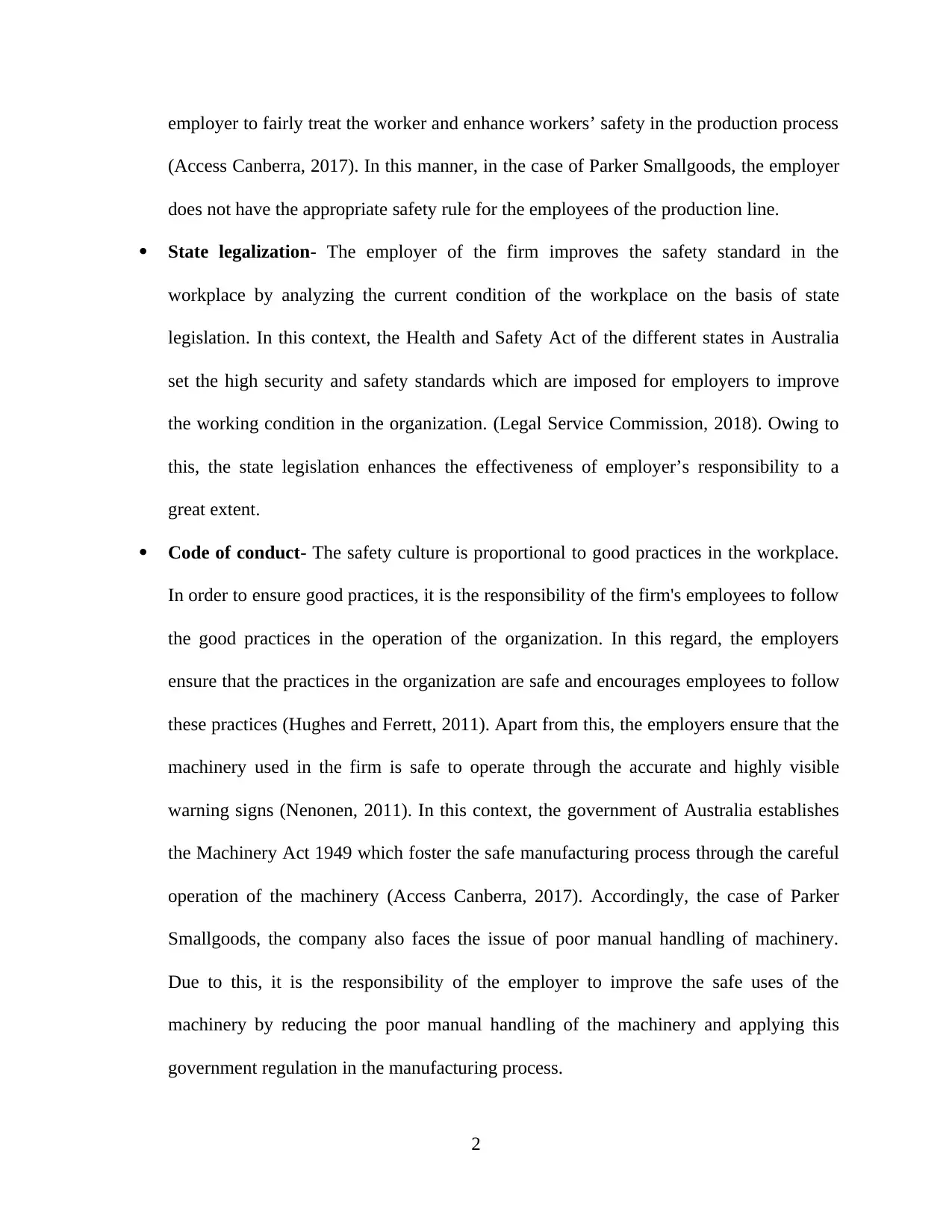
employer to fairly treat the worker and enhance workers’ safety in the production process
(Access Canberra, 2017). In this manner, in the case of Parker Smallgoods, the employer
does not have the appropriate safety rule for the employees of the production line.
State legalization- The employer of the firm improves the safety standard in the
workplace by analyzing the current condition of the workplace on the basis of state
legislation. In this context, the Health and Safety Act of the different states in Australia
set the high security and safety standards which are imposed for employers to improve
the working condition in the organization. (Legal Service Commission, 2018). Owing to
this, the state legislation enhances the effectiveness of employer’s responsibility to a
great extent.
Code of conduct- The safety culture is proportional to good practices in the workplace.
In order to ensure good practices, it is the responsibility of the firm's employees to follow
the good practices in the operation of the organization. In this regard, the employers
ensure that the practices in the organization are safe and encourages employees to follow
these practices (Hughes and Ferrett, 2011). Apart from this, the employers ensure that the
machinery used in the firm is safe to operate through the accurate and highly visible
warning signs (Nenonen, 2011). In this context, the government of Australia establishes
the Machinery Act 1949 which foster the safe manufacturing process through the careful
operation of the machinery (Access Canberra, 2017). Accordingly, the case of Parker
Smallgoods, the company also faces the issue of poor manual handling of machinery.
Due to this, it is the responsibility of the employer to improve the safe uses of the
machinery by reducing the poor manual handling of the machinery and applying this
government regulation in the manufacturing process.
2
(Access Canberra, 2017). In this manner, in the case of Parker Smallgoods, the employer
does not have the appropriate safety rule for the employees of the production line.
State legalization- The employer of the firm improves the safety standard in the
workplace by analyzing the current condition of the workplace on the basis of state
legislation. In this context, the Health and Safety Act of the different states in Australia
set the high security and safety standards which are imposed for employers to improve
the working condition in the organization. (Legal Service Commission, 2018). Owing to
this, the state legislation enhances the effectiveness of employer’s responsibility to a
great extent.
Code of conduct- The safety culture is proportional to good practices in the workplace.
In order to ensure good practices, it is the responsibility of the firm's employees to follow
the good practices in the operation of the organization. In this regard, the employers
ensure that the practices in the organization are safe and encourages employees to follow
these practices (Hughes and Ferrett, 2011). Apart from this, the employers ensure that the
machinery used in the firm is safe to operate through the accurate and highly visible
warning signs (Nenonen, 2011). In this context, the government of Australia establishes
the Machinery Act 1949 which foster the safe manufacturing process through the careful
operation of the machinery (Access Canberra, 2017). Accordingly, the case of Parker
Smallgoods, the company also faces the issue of poor manual handling of machinery.
Due to this, it is the responsibility of the employer to improve the safe uses of the
machinery by reducing the poor manual handling of the machinery and applying this
government regulation in the manufacturing process.
2
Paraphrase This Document
Need a fresh take? Get an instant paraphrase of this document with our AI Paraphraser
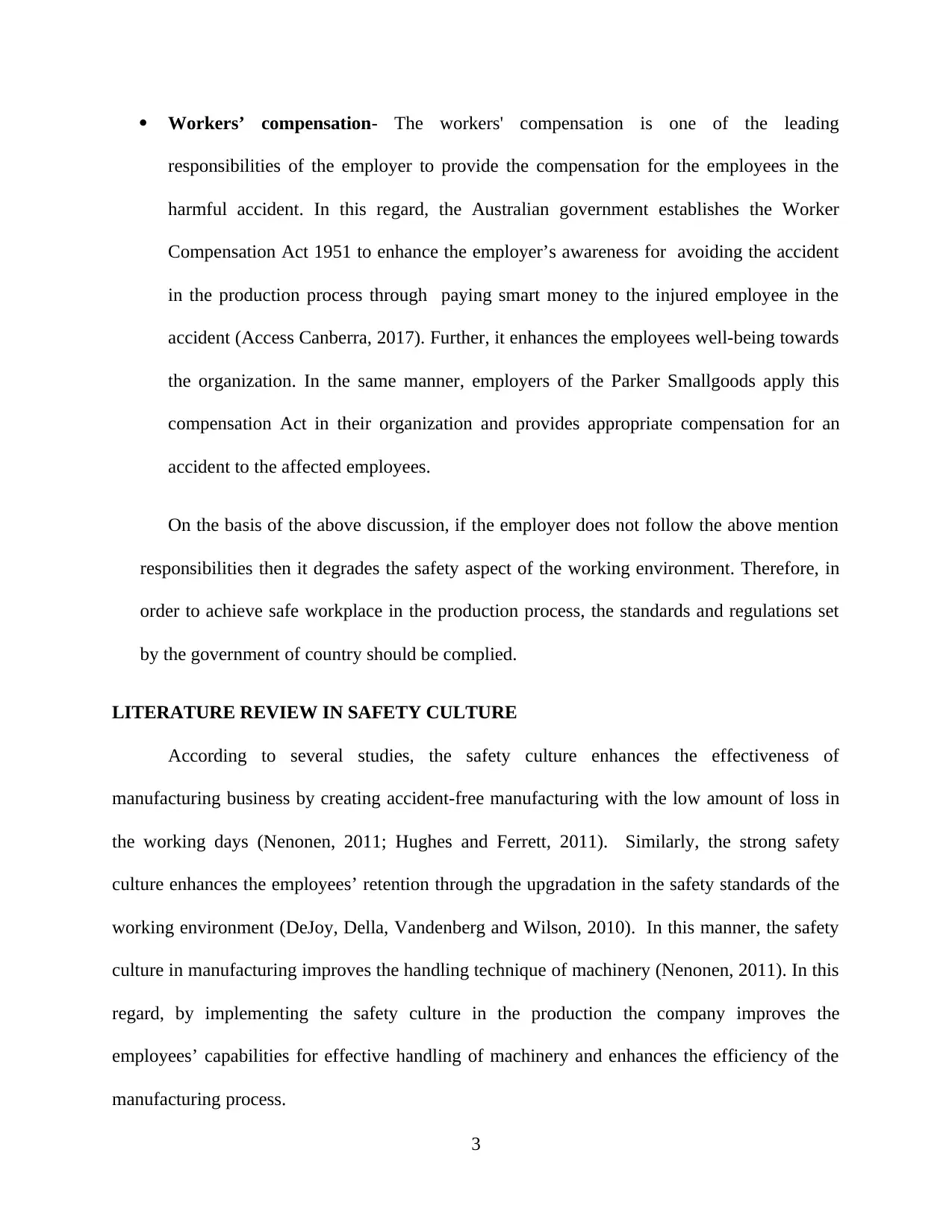
Workers’ compensation- The workers' compensation is one of the leading
responsibilities of the employer to provide the compensation for the employees in the
harmful accident. In this regard, the Australian government establishes the Worker
Compensation Act 1951 to enhance the employer’s awareness for avoiding the accident
in the production process through paying smart money to the injured employee in the
accident (Access Canberra, 2017). Further, it enhances the employees well-being towards
the organization. In the same manner, employers of the Parker Smallgoods apply this
compensation Act in their organization and provides appropriate compensation for an
accident to the affected employees.
On the basis of the above discussion, if the employer does not follow the above mention
responsibilities then it degrades the safety aspect of the working environment. Therefore, in
order to achieve safe workplace in the production process, the standards and regulations set
by the government of country should be complied.
LITERATURE REVIEW IN SAFETY CULTURE
According to several studies, the safety culture enhances the effectiveness of
manufacturing business by creating accident-free manufacturing with the low amount of loss in
the working days (Nenonen, 2011; Hughes and Ferrett, 2011). Similarly, the strong safety
culture enhances the employees’ retention through the upgradation in the safety standards of the
working environment (DeJoy, Della, Vandenberg and Wilson, 2010). In this manner, the safety
culture in manufacturing improves the handling technique of machinery (Nenonen, 2011). In this
regard, by implementing the safety culture in the production the company improves the
employees’ capabilities for effective handling of machinery and enhances the efficiency of the
manufacturing process.
3
responsibilities of the employer to provide the compensation for the employees in the
harmful accident. In this regard, the Australian government establishes the Worker
Compensation Act 1951 to enhance the employer’s awareness for avoiding the accident
in the production process through paying smart money to the injured employee in the
accident (Access Canberra, 2017). Further, it enhances the employees well-being towards
the organization. In the same manner, employers of the Parker Smallgoods apply this
compensation Act in their organization and provides appropriate compensation for an
accident to the affected employees.
On the basis of the above discussion, if the employer does not follow the above mention
responsibilities then it degrades the safety aspect of the working environment. Therefore, in
order to achieve safe workplace in the production process, the standards and regulations set
by the government of country should be complied.
LITERATURE REVIEW IN SAFETY CULTURE
According to several studies, the safety culture enhances the effectiveness of
manufacturing business by creating accident-free manufacturing with the low amount of loss in
the working days (Nenonen, 2011; Hughes and Ferrett, 2011). Similarly, the strong safety
culture enhances the employees’ retention through the upgradation in the safety standards of the
working environment (DeJoy, Della, Vandenberg and Wilson, 2010). In this manner, the safety
culture in manufacturing improves the handling technique of machinery (Nenonen, 2011). In this
regard, by implementing the safety culture in the production the company improves the
employees’ capabilities for effective handling of machinery and enhances the efficiency of the
manufacturing process.
3
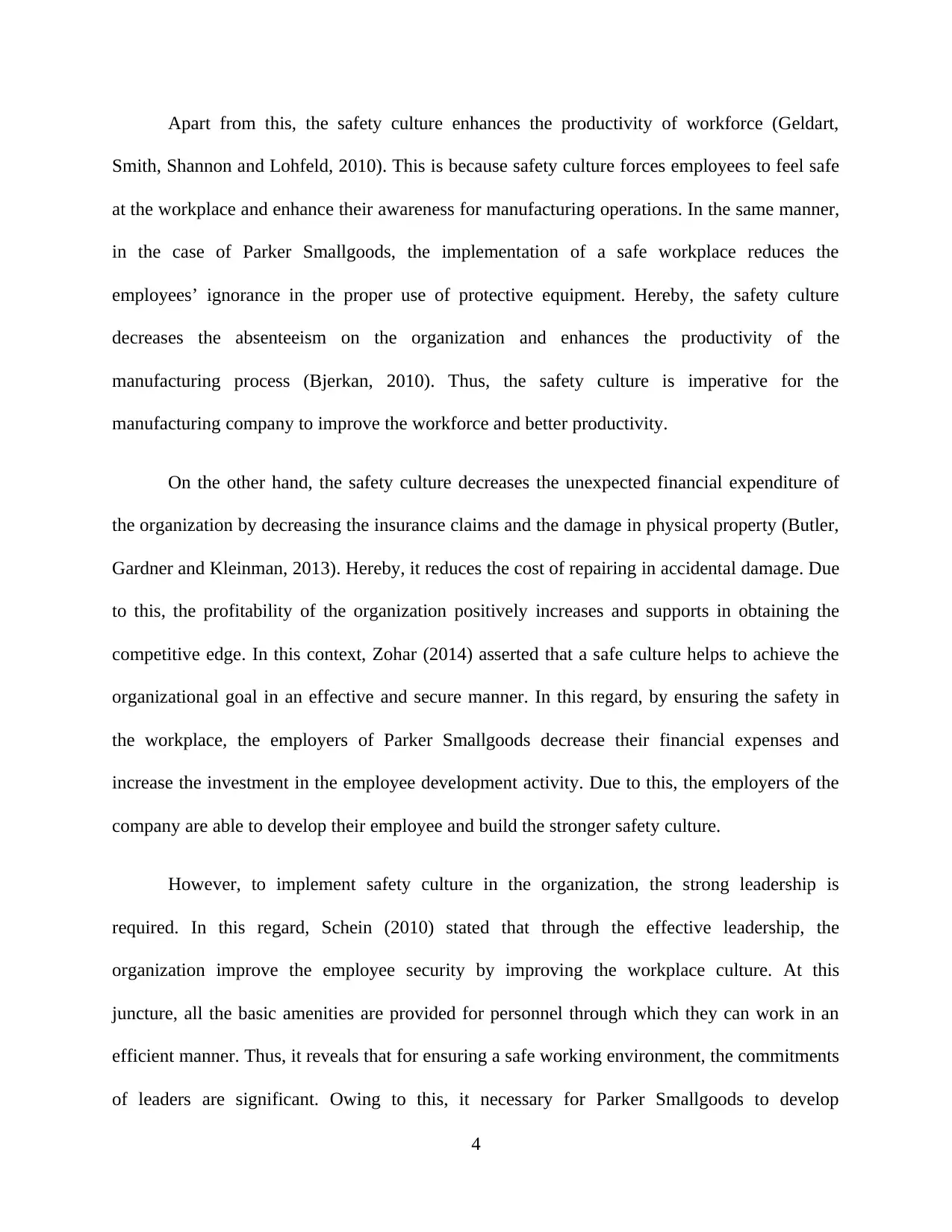
Apart from this, the safety culture enhances the productivity of workforce (Geldart,
Smith, Shannon and Lohfeld, 2010). This is because safety culture forces employees to feel safe
at the workplace and enhance their awareness for manufacturing operations. In the same manner,
in the case of Parker Smallgoods, the implementation of a safe workplace reduces the
employees’ ignorance in the proper use of protective equipment. Hereby, the safety culture
decreases the absenteeism on the organization and enhances the productivity of the
manufacturing process (Bjerkan, 2010). Thus, the safety culture is imperative for the
manufacturing company to improve the workforce and better productivity.
On the other hand, the safety culture decreases the unexpected financial expenditure of
the organization by decreasing the insurance claims and the damage in physical property (Butler,
Gardner and Kleinman, 2013). Hereby, it reduces the cost of repairing in accidental damage. Due
to this, the profitability of the organization positively increases and supports in obtaining the
competitive edge. In this context, Zohar (2014) asserted that a safe culture helps to achieve the
organizational goal in an effective and secure manner. In this regard, by ensuring the safety in
the workplace, the employers of Parker Smallgoods decrease their financial expenses and
increase the investment in the employee development activity. Due to this, the employers of the
company are able to develop their employee and build the stronger safety culture.
However, to implement safety culture in the organization, the strong leadership is
required. In this regard, Schein (2010) stated that through the effective leadership, the
organization improve the employee security by improving the workplace culture. At this
juncture, all the basic amenities are provided for personnel through which they can work in an
efficient manner. Thus, it reveals that for ensuring a safe working environment, the commitments
of leaders are significant. Owing to this, it necessary for Parker Smallgoods to develop
4
Smith, Shannon and Lohfeld, 2010). This is because safety culture forces employees to feel safe
at the workplace and enhance their awareness for manufacturing operations. In the same manner,
in the case of Parker Smallgoods, the implementation of a safe workplace reduces the
employees’ ignorance in the proper use of protective equipment. Hereby, the safety culture
decreases the absenteeism on the organization and enhances the productivity of the
manufacturing process (Bjerkan, 2010). Thus, the safety culture is imperative for the
manufacturing company to improve the workforce and better productivity.
On the other hand, the safety culture decreases the unexpected financial expenditure of
the organization by decreasing the insurance claims and the damage in physical property (Butler,
Gardner and Kleinman, 2013). Hereby, it reduces the cost of repairing in accidental damage. Due
to this, the profitability of the organization positively increases and supports in obtaining the
competitive edge. In this context, Zohar (2014) asserted that a safe culture helps to achieve the
organizational goal in an effective and secure manner. In this regard, by ensuring the safety in
the workplace, the employers of Parker Smallgoods decrease their financial expenses and
increase the investment in the employee development activity. Due to this, the employers of the
company are able to develop their employee and build the stronger safety culture.
However, to implement safety culture in the organization, the strong leadership is
required. In this regard, Schein (2010) stated that through the effective leadership, the
organization improve the employee security by improving the workplace culture. At this
juncture, all the basic amenities are provided for personnel through which they can work in an
efficient manner. Thus, it reveals that for ensuring a safe working environment, the commitments
of leaders are significant. Owing to this, it necessary for Parker Smallgoods to develop
4
⊘ This is a preview!⊘
Do you want full access?
Subscribe today to unlock all pages.

Trusted by 1+ million students worldwide
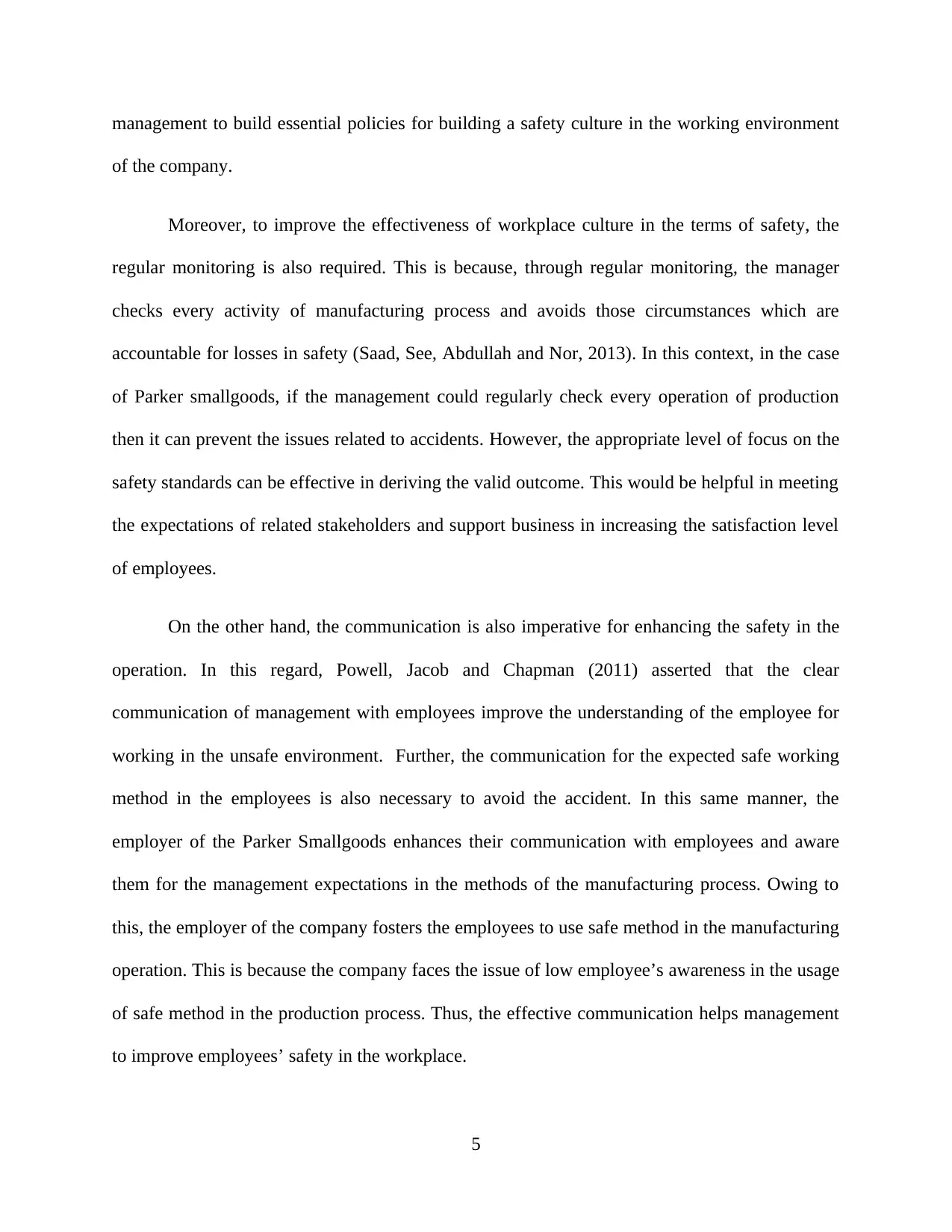
management to build essential policies for building a safety culture in the working environment
of the company.
Moreover, to improve the effectiveness of workplace culture in the terms of safety, the
regular monitoring is also required. This is because, through regular monitoring, the manager
checks every activity of manufacturing process and avoids those circumstances which are
accountable for losses in safety (Saad, See, Abdullah and Nor, 2013). In this context, in the case
of Parker smallgoods, if the management could regularly check every operation of production
then it can prevent the issues related to accidents. However, the appropriate level of focus on the
safety standards can be effective in deriving the valid outcome. This would be helpful in meeting
the expectations of related stakeholders and support business in increasing the satisfaction level
of employees.
On the other hand, the communication is also imperative for enhancing the safety in the
operation. In this regard, Powell, Jacob and Chapman (2011) asserted that the clear
communication of management with employees improve the understanding of the employee for
working in the unsafe environment. Further, the communication for the expected safe working
method in the employees is also necessary to avoid the accident. In this same manner, the
employer of the Parker Smallgoods enhances their communication with employees and aware
them for the management expectations in the methods of the manufacturing process. Owing to
this, the employer of the company fosters the employees to use safe method in the manufacturing
operation. This is because the company faces the issue of low employee’s awareness in the usage
of safe method in the production process. Thus, the effective communication helps management
to improve employees’ safety in the workplace.
5
of the company.
Moreover, to improve the effectiveness of workplace culture in the terms of safety, the
regular monitoring is also required. This is because, through regular monitoring, the manager
checks every activity of manufacturing process and avoids those circumstances which are
accountable for losses in safety (Saad, See, Abdullah and Nor, 2013). In this context, in the case
of Parker smallgoods, if the management could regularly check every operation of production
then it can prevent the issues related to accidents. However, the appropriate level of focus on the
safety standards can be effective in deriving the valid outcome. This would be helpful in meeting
the expectations of related stakeholders and support business in increasing the satisfaction level
of employees.
On the other hand, the communication is also imperative for enhancing the safety in the
operation. In this regard, Powell, Jacob and Chapman (2011) asserted that the clear
communication of management with employees improve the understanding of the employee for
working in the unsafe environment. Further, the communication for the expected safe working
method in the employees is also necessary to avoid the accident. In this same manner, the
employer of the Parker Smallgoods enhances their communication with employees and aware
them for the management expectations in the methods of the manufacturing process. Owing to
this, the employer of the company fosters the employees to use safe method in the manufacturing
operation. This is because the company faces the issue of low employee’s awareness in the usage
of safe method in the production process. Thus, the effective communication helps management
to improve employees’ safety in the workplace.
5
Paraphrase This Document
Need a fresh take? Get an instant paraphrase of this document with our AI Paraphraser
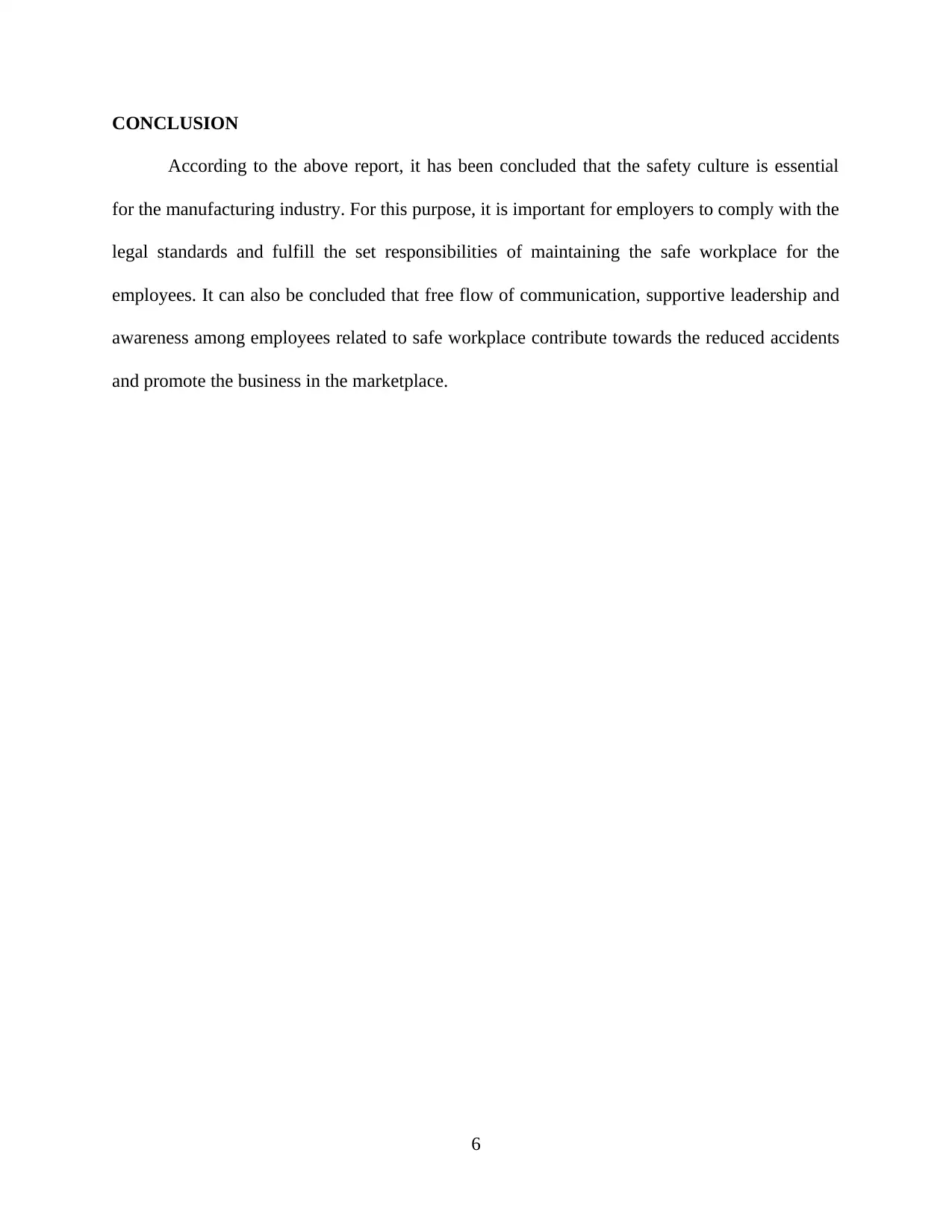
CONCLUSION
According to the above report, it has been concluded that the safety culture is essential
for the manufacturing industry. For this purpose, it is important for employers to comply with the
legal standards and fulfill the set responsibilities of maintaining the safe workplace for the
employees. It can also be concluded that free flow of communication, supportive leadership and
awareness among employees related to safe workplace contribute towards the reduced accidents
and promote the business in the marketplace.
6
According to the above report, it has been concluded that the safety culture is essential
for the manufacturing industry. For this purpose, it is important for employers to comply with the
legal standards and fulfill the set responsibilities of maintaining the safe workplace for the
employees. It can also be concluded that free flow of communication, supportive leadership and
awareness among employees related to safe workplace contribute towards the reduced accidents
and promote the business in the marketplace.
6
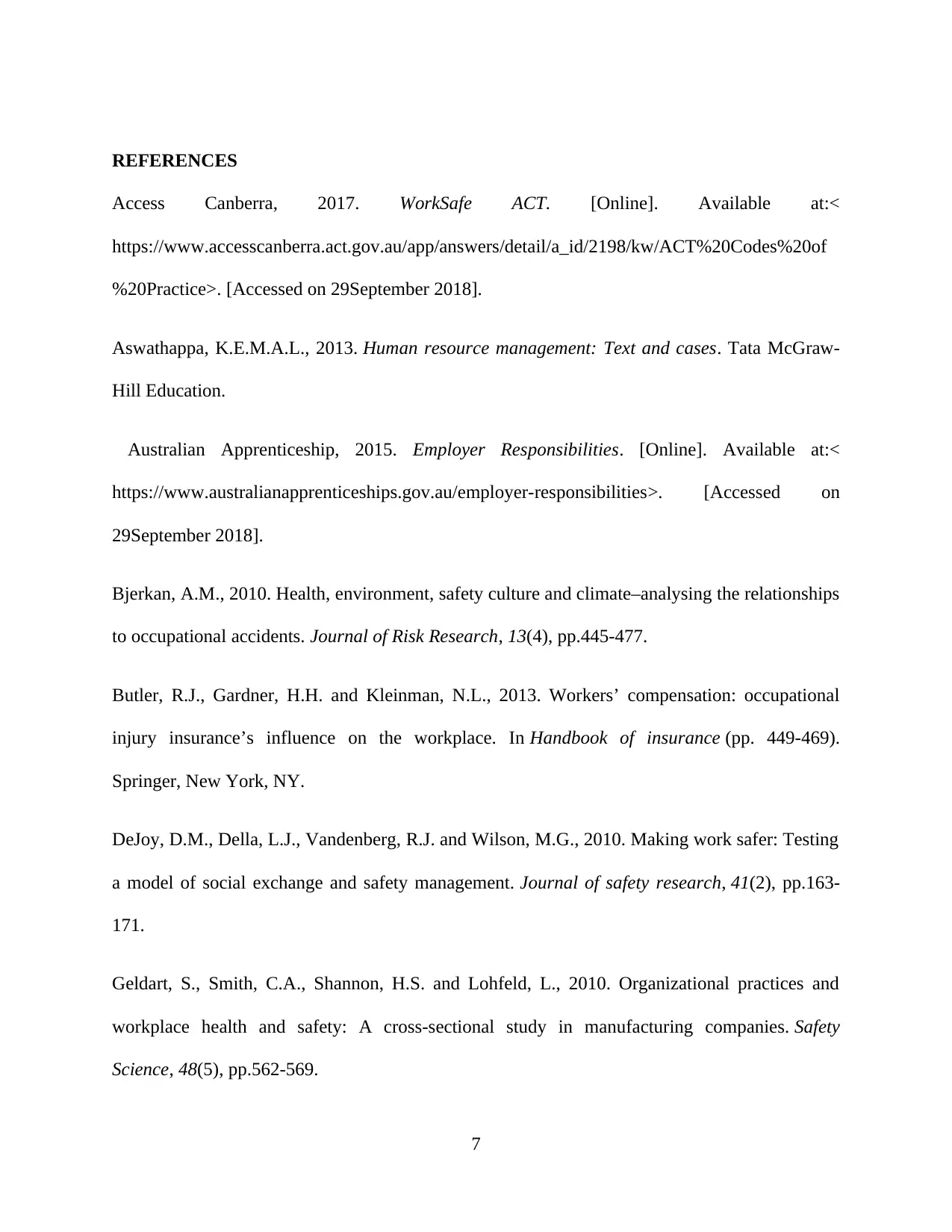
REFERENCES
Access Canberra, 2017. WorkSafe ACT. [Online]. Available at:<
https://www.accesscanberra.act.gov.au/app/answers/detail/a_id/2198/kw/ACT%20Codes%20of
%20Practice>. [Accessed on 29September 2018].
Aswathappa, K.E.M.A.L., 2013. Human resource management: Text and cases. Tata McGraw-
Hill Education.
Australian Apprenticeship, 2015. Employer Responsibilities. [Online]. Available at:<
https://www.australianapprenticeships.gov.au/employer-responsibilities>. [Accessed on
29September 2018].
Bjerkan, A.M., 2010. Health, environment, safety culture and climate–analysing the relationships
to occupational accidents. Journal of Risk Research, 13(4), pp.445-477.
Butler, R.J., Gardner, H.H. and Kleinman, N.L., 2013. Workers’ compensation: occupational
injury insurance’s influence on the workplace. In Handbook of insurance (pp. 449-469).
Springer, New York, NY.
DeJoy, D.M., Della, L.J., Vandenberg, R.J. and Wilson, M.G., 2010. Making work safer: Testing
a model of social exchange and safety management. Journal of safety research, 41(2), pp.163-
171.
Geldart, S., Smith, C.A., Shannon, H.S. and Lohfeld, L., 2010. Organizational practices and
workplace health and safety: A cross-sectional study in manufacturing companies. Safety
Science, 48(5), pp.562-569.
7
Access Canberra, 2017. WorkSafe ACT. [Online]. Available at:<
https://www.accesscanberra.act.gov.au/app/answers/detail/a_id/2198/kw/ACT%20Codes%20of
%20Practice>. [Accessed on 29September 2018].
Aswathappa, K.E.M.A.L., 2013. Human resource management: Text and cases. Tata McGraw-
Hill Education.
Australian Apprenticeship, 2015. Employer Responsibilities. [Online]. Available at:<
https://www.australianapprenticeships.gov.au/employer-responsibilities>. [Accessed on
29September 2018].
Bjerkan, A.M., 2010. Health, environment, safety culture and climate–analysing the relationships
to occupational accidents. Journal of Risk Research, 13(4), pp.445-477.
Butler, R.J., Gardner, H.H. and Kleinman, N.L., 2013. Workers’ compensation: occupational
injury insurance’s influence on the workplace. In Handbook of insurance (pp. 449-469).
Springer, New York, NY.
DeJoy, D.M., Della, L.J., Vandenberg, R.J. and Wilson, M.G., 2010. Making work safer: Testing
a model of social exchange and safety management. Journal of safety research, 41(2), pp.163-
171.
Geldart, S., Smith, C.A., Shannon, H.S. and Lohfeld, L., 2010. Organizational practices and
workplace health and safety: A cross-sectional study in manufacturing companies. Safety
Science, 48(5), pp.562-569.
7
⊘ This is a preview!⊘
Do you want full access?
Subscribe today to unlock all pages.

Trusted by 1+ million students worldwide
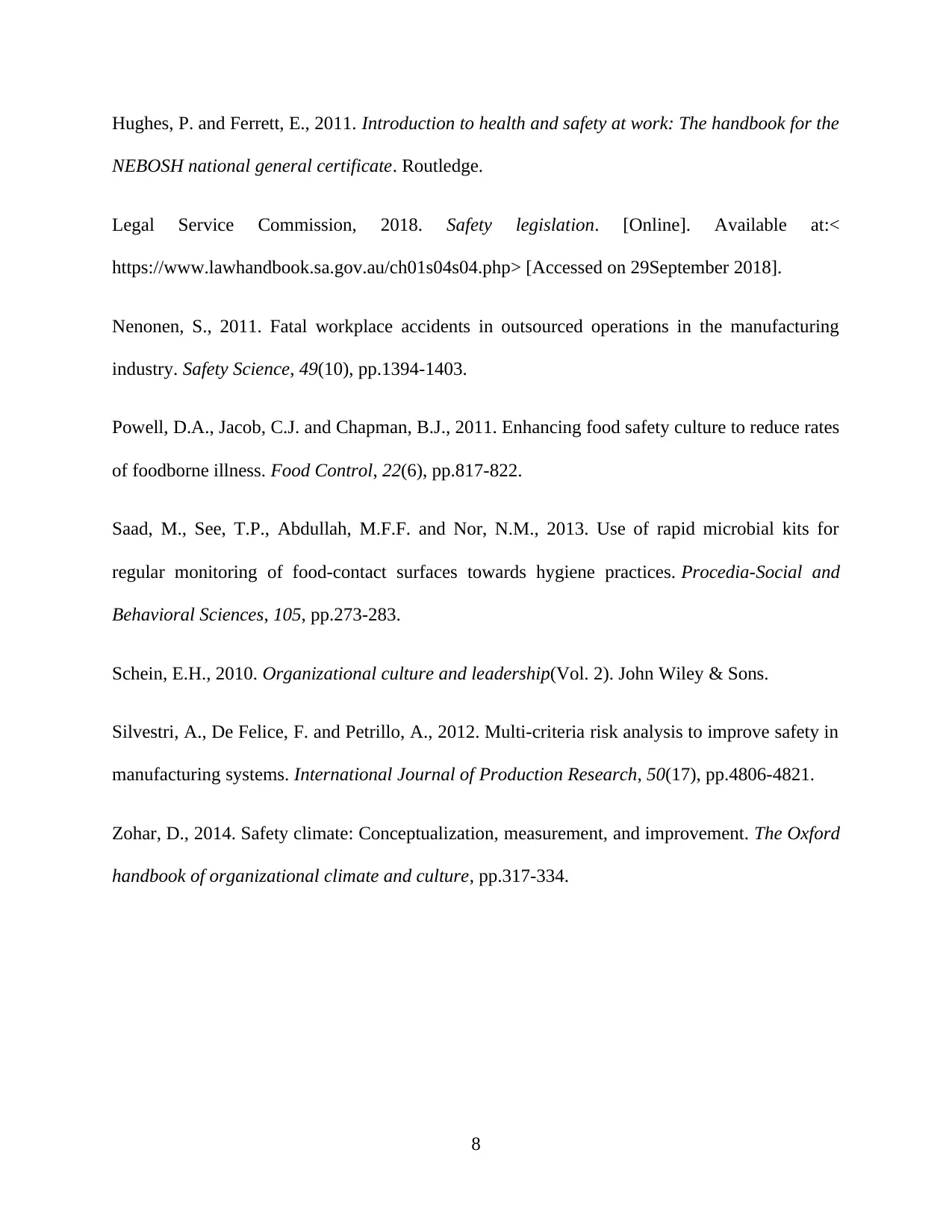
Hughes, P. and Ferrett, E., 2011. Introduction to health and safety at work: The handbook for the
NEBOSH national general certificate. Routledge.
Legal Service Commission, 2018. Safety legislation. [Online]. Available at:<
https://www.lawhandbook.sa.gov.au/ch01s04s04.php> [Accessed on 29September 2018].
Nenonen, S., 2011. Fatal workplace accidents in outsourced operations in the manufacturing
industry. Safety Science, 49(10), pp.1394-1403.
Powell, D.A., Jacob, C.J. and Chapman, B.J., 2011. Enhancing food safety culture to reduce rates
of foodborne illness. Food Control, 22(6), pp.817-822.
Saad, M., See, T.P., Abdullah, M.F.F. and Nor, N.M., 2013. Use of rapid microbial kits for
regular monitoring of food-contact surfaces towards hygiene practices. Procedia-Social and
Behavioral Sciences, 105, pp.273-283.
Schein, E.H., 2010. Organizational culture and leadership(Vol. 2). John Wiley & Sons.
Silvestri, A., De Felice, F. and Petrillo, A., 2012. Multi-criteria risk analysis to improve safety in
manufacturing systems. International Journal of Production Research, 50(17), pp.4806-4821.
Zohar, D., 2014. Safety climate: Conceptualization, measurement, and improvement. The Oxford
handbook of organizational climate and culture, pp.317-334.
8
NEBOSH national general certificate. Routledge.
Legal Service Commission, 2018. Safety legislation. [Online]. Available at:<
https://www.lawhandbook.sa.gov.au/ch01s04s04.php> [Accessed on 29September 2018].
Nenonen, S., 2011. Fatal workplace accidents in outsourced operations in the manufacturing
industry. Safety Science, 49(10), pp.1394-1403.
Powell, D.A., Jacob, C.J. and Chapman, B.J., 2011. Enhancing food safety culture to reduce rates
of foodborne illness. Food Control, 22(6), pp.817-822.
Saad, M., See, T.P., Abdullah, M.F.F. and Nor, N.M., 2013. Use of rapid microbial kits for
regular monitoring of food-contact surfaces towards hygiene practices. Procedia-Social and
Behavioral Sciences, 105, pp.273-283.
Schein, E.H., 2010. Organizational culture and leadership(Vol. 2). John Wiley & Sons.
Silvestri, A., De Felice, F. and Petrillo, A., 2012. Multi-criteria risk analysis to improve safety in
manufacturing systems. International Journal of Production Research, 50(17), pp.4806-4821.
Zohar, D., 2014. Safety climate: Conceptualization, measurement, and improvement. The Oxford
handbook of organizational climate and culture, pp.317-334.
8
1 out of 10
Related Documents
Your All-in-One AI-Powered Toolkit for Academic Success.
+13062052269
info@desklib.com
Available 24*7 on WhatsApp / Email
![[object Object]](/_next/static/media/star-bottom.7253800d.svg)
Unlock your academic potential
Copyright © 2020–2025 A2Z Services. All Rights Reserved. Developed and managed by ZUCOL.




